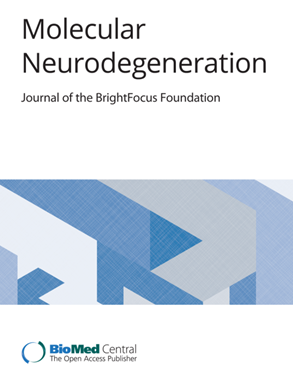A novel alpha-synuclein G14R missense variant is associated with atypical neuropathological features
IF 17.5
1区 医学
Q1 NEUROSCIENCES
引用次数: 0
Abstract
Parkinson’s disease (PD) affects millions of people worldwide, but only 5–10% of patients suffer from a monogenic forms of the disease with Mendelian inheritance. SNCA, the gene encoding for the protein alpha-synuclein (aSyn), was the first to be associated with familial forms of PD and, since then, several missense variants and multiplications of the gene have been established as rare causes of autosomal dominant forms of PD. In this study, we report the identification of a novel SNCA mutation in a patient that presented with a complex neurogenerative disorder, and unconventional neuropathological findings. We also performed in depth molecular studies of the effects of the novel aSyn mutation. A patient carrying the novel aSyn missense mutation and the family members were studied. We present the clinical features, genetic testing—whole exome sequencing (WES), and neuropathological findings. The functional consequences of this aSyn variant were extensively investigated using biochemical, biophysical, and cellular assays. The patient exhibited a complex neurodegenerative disease that included generalized myocloni, bradykinesia, dystonia of the left arm and apraxia. WES identified a novel heterozygous SNCA variant (cDNA 40G > A; protein G14R). Neuropathological examination showed extensive atypical aSyn pathology with frontotemporal lobar degeneration (FTLD)-type distribution and nigral degeneration pattern with abundant ring-like neuronal inclusions, and few oligodendroglial inclusions. Sanger sequencing confirmed the SNCA variant in one healthy, 86-year-old parent of the patient suggesting incomplete penetrance. NMR studies suggest that the G14R mutation induces a local structural alteration in aSyn, and lower thioflavin T binding in in vitro fibrillization assays. Interestingly, the G14R aSyn fibers display different fibrillar morphologies than Lewy bodies as revealed by cryo-electron microscopy. Cellular studies of the G14R variant revealed increased inclusion formation, enhanced membrane association, and impaired dynamic reversibility of serine‐129 phosphorylation. The atypical neuropathological features observed, which are reminiscent of those observed for the G51D aSyn variant, suggest a causal role of the SNCA variant with a distinct clinical and pathological phenotype, which is further supported by the properties of the mutant aSyn.一种新的α -突触核蛋白G14R错义变体与非典型神经病理特征相关
帕金森病(PD)影响着全世界数百万人,但只有5-10%的患者患有孟德尔遗传的单基因形式的疾病。编码α -突触核蛋白(aSyn)的基因SNCA是第一个与家族性帕金森病相关的基因,从那时起,该基因的一些错义变异和增殖已被确定为常染色体显性帕金森病的罕见病因。在这项研究中,我们报告了一种新的SNCA突变在患者的鉴定,该患者表现为复杂的神经生成障碍,并有非常规的神经病理结果。我们还进行了深入的分子研究的影响,新的aSyn突变。本文对1例新型aSyn错义突变患者及其家庭成员进行了研究。我们提出临床特征,基因检测-全外显子组测序(WES)和神经病理结果。使用生化、生物物理和细胞分析广泛研究了这种aSyn变异的功能后果。患者表现出复杂的神经退行性疾病,包括全身性肌阵挛、运动迟缓、左臂肌张力障碍和失用症。WES鉴定出一种新的杂合SNCA变异(cDNA 40G > a; protein G14R)。神经病理检查显示广泛的非典型aSyn病理,伴有额颞叶变性(FTLD)型分布和神经变性模式,伴丰富的环状神经元包涵体和少量少突胶质包涵体。Sanger测序在患者的一位86岁的健康父母中证实了SNCA变异,表明不完全外显。核磁共振研究表明,G14R突变诱导了aSyn的局部结构改变,并在体外纤化实验中降低了硫黄素T的结合。有趣的是,G14R aSyn纤维在低温电子显微镜下显示出与路易体不同的纤维形态。G14R变异体的细胞研究显示,包涵体形成增加,膜结合增强,丝氨酸- 129磷酸化的动态可逆性受损。观察到的非典型神经病理特征与G51D aSyn变体相似,表明SNCA变体具有独特的临床和病理表型,这进一步得到了突变型aSyn的特性的支持。
本文章由计算机程序翻译,如有差异,请以英文原文为准。
求助全文
约1分钟内获得全文
求助全文
来源期刊

Molecular Neurodegeneration
医学-神经科学
CiteScore
23.00
自引率
4.60%
发文量
78
审稿时长
6-12 weeks
期刊介绍:
Molecular Neurodegeneration, an open-access, peer-reviewed journal, comprehensively covers neurodegeneration research at the molecular and cellular levels.
Neurodegenerative diseases, such as Alzheimer's, Parkinson's, Huntington's, and prion diseases, fall under its purview. These disorders, often linked to advanced aging and characterized by varying degrees of dementia, pose a significant public health concern with the growing aging population. Recent strides in understanding the molecular and cellular mechanisms of these neurodegenerative disorders offer valuable insights into their pathogenesis.
 求助内容:
求助内容: 应助结果提醒方式:
应助结果提醒方式:


